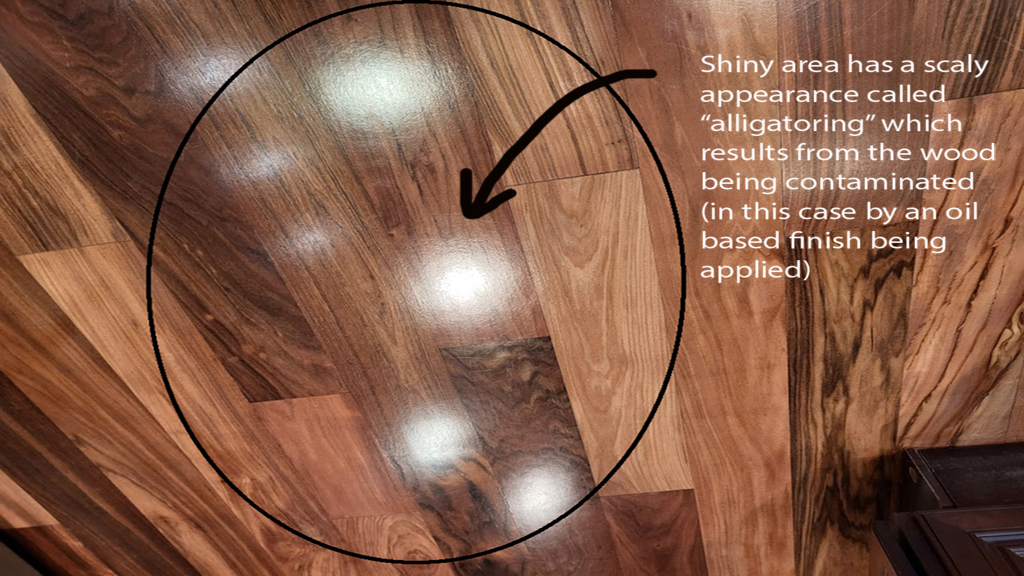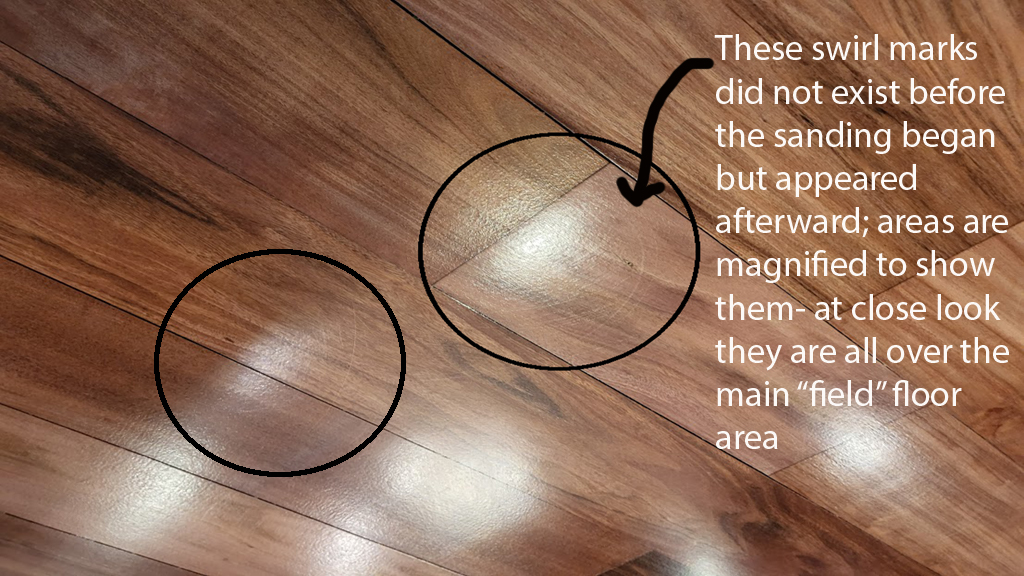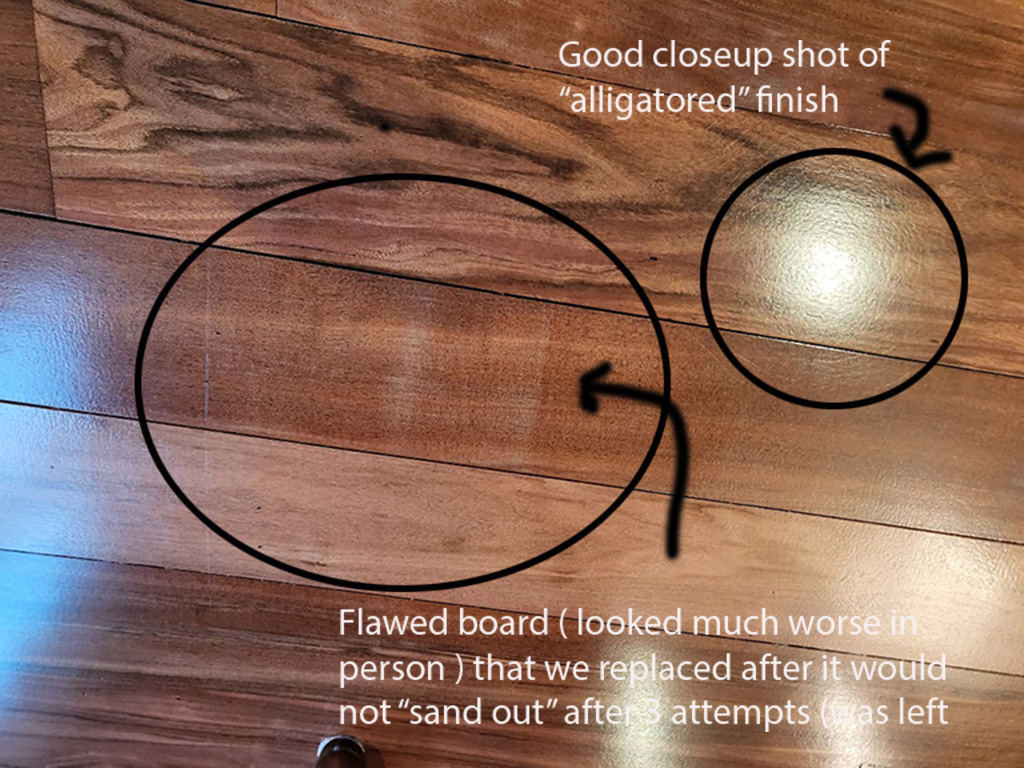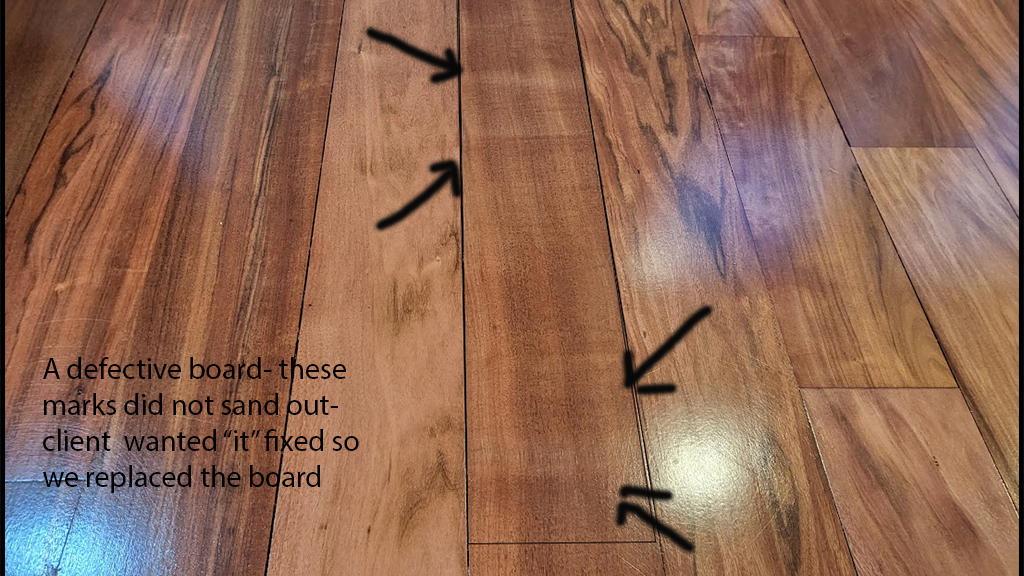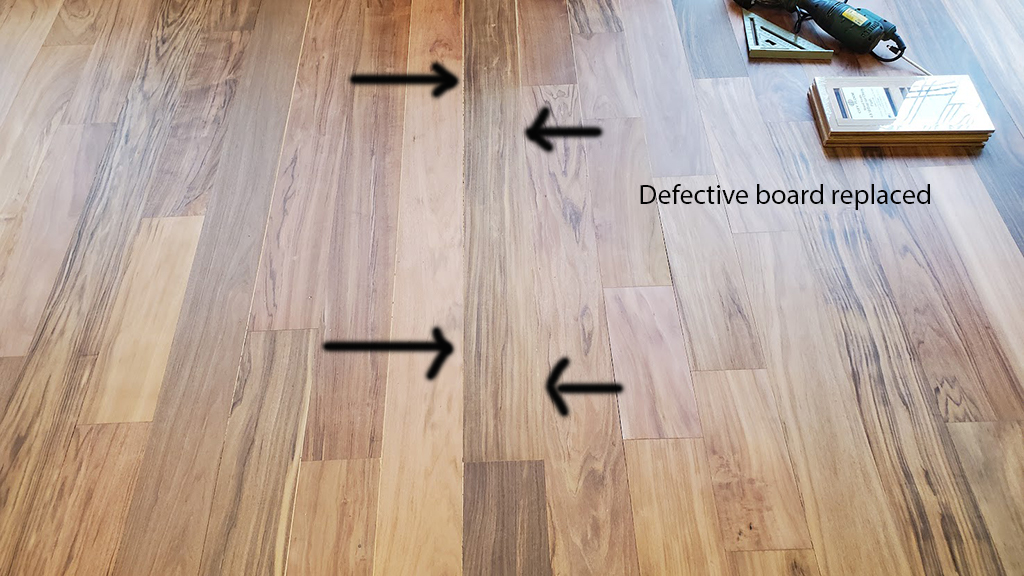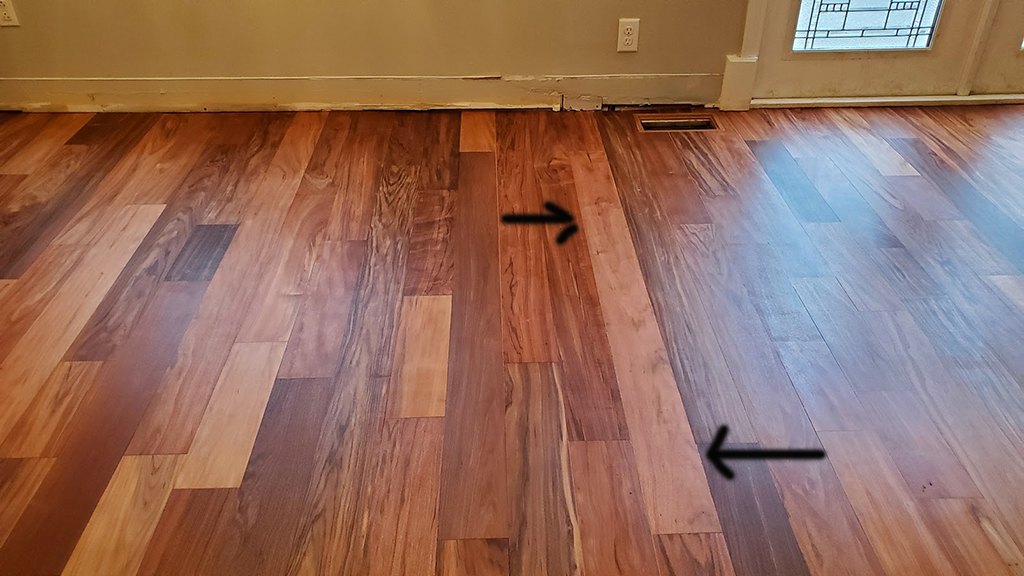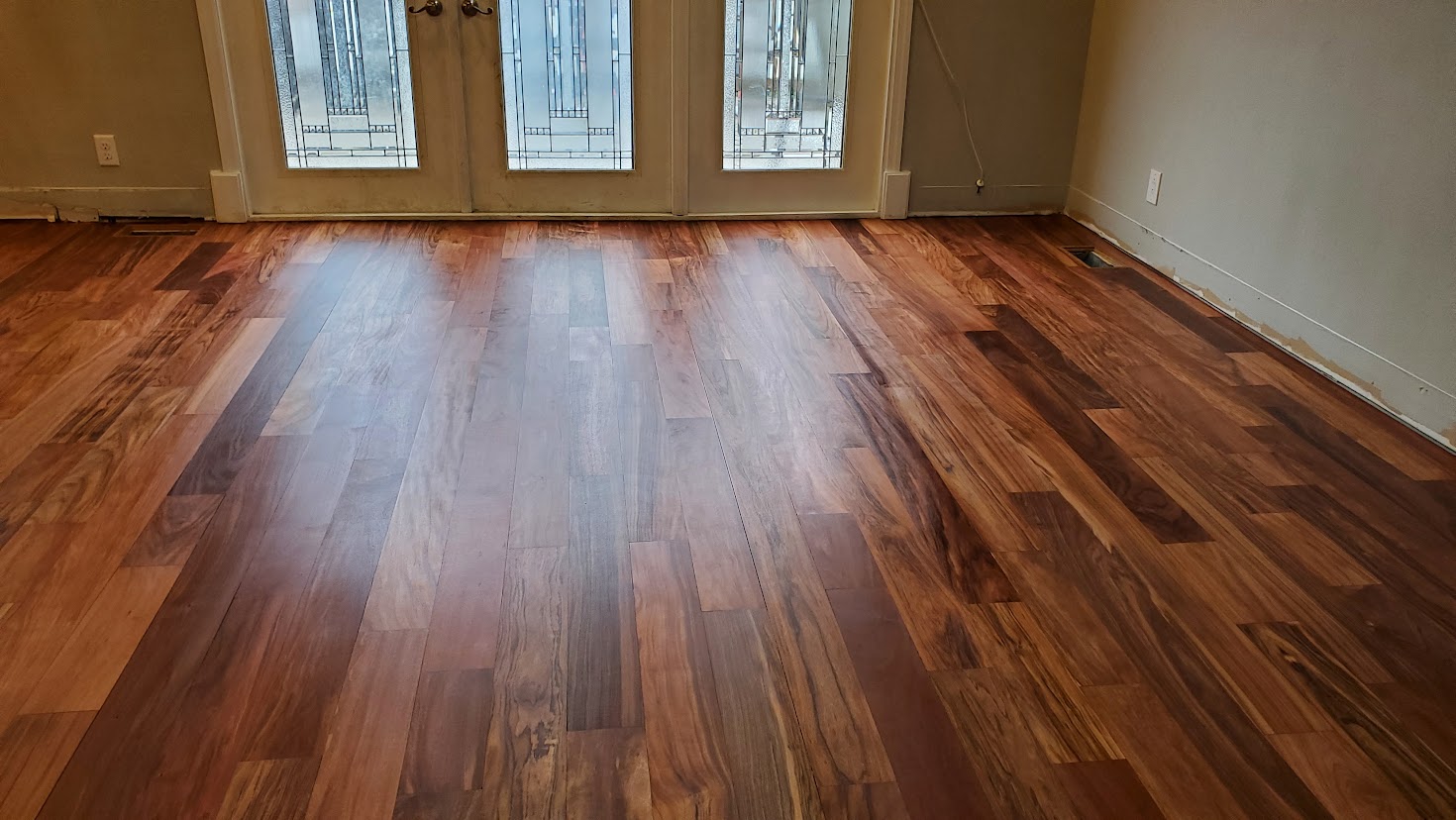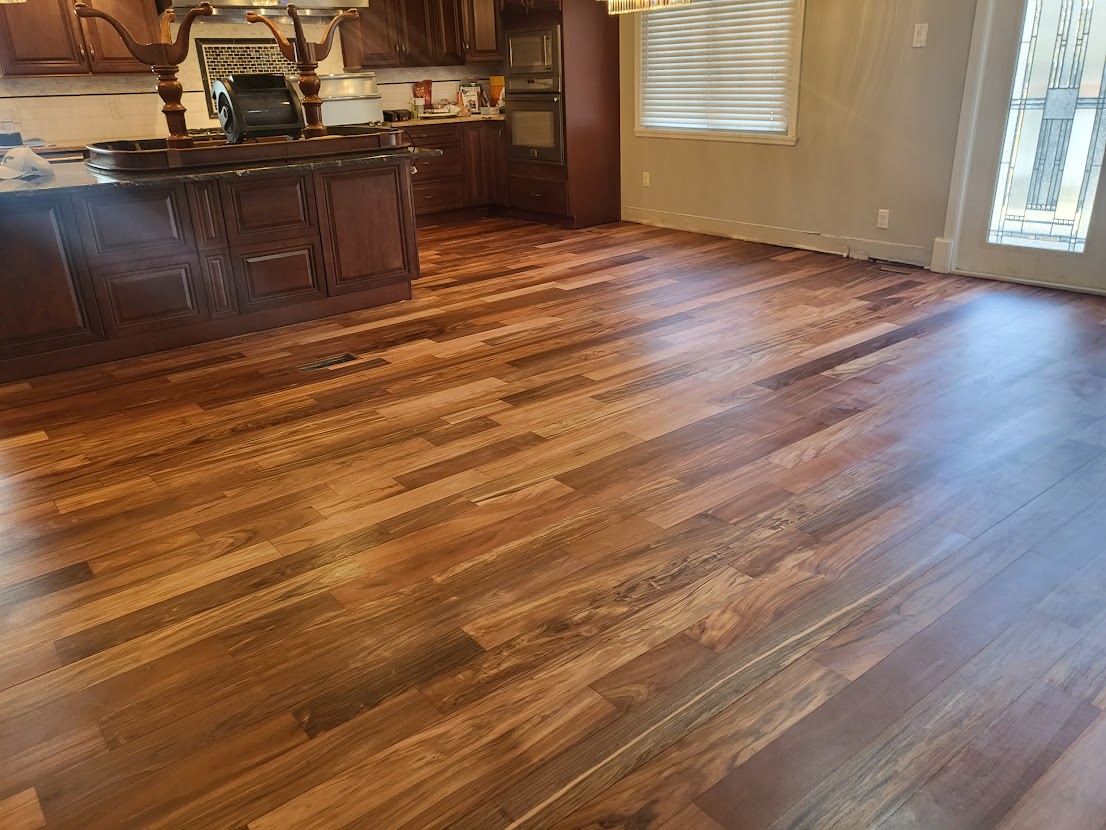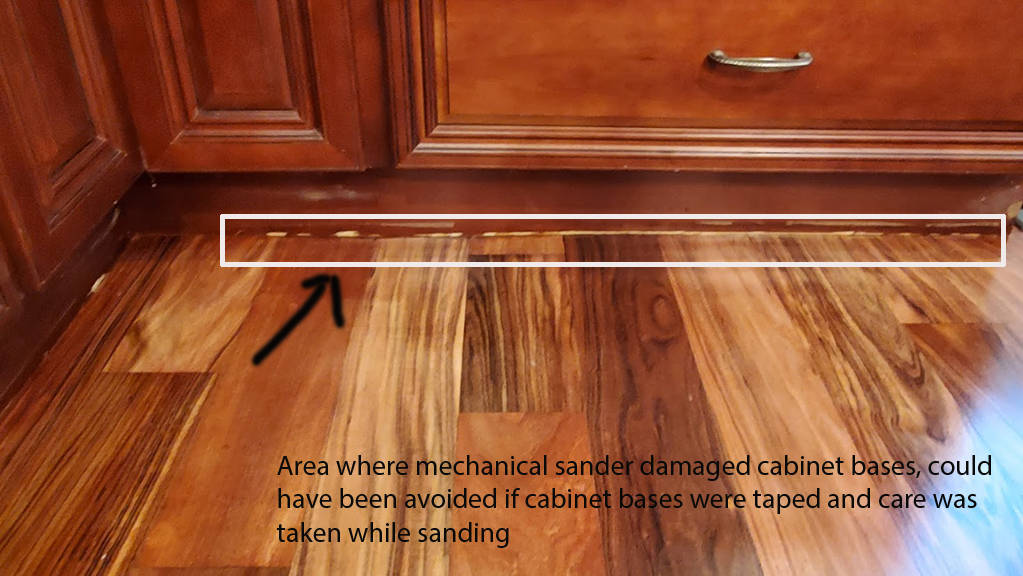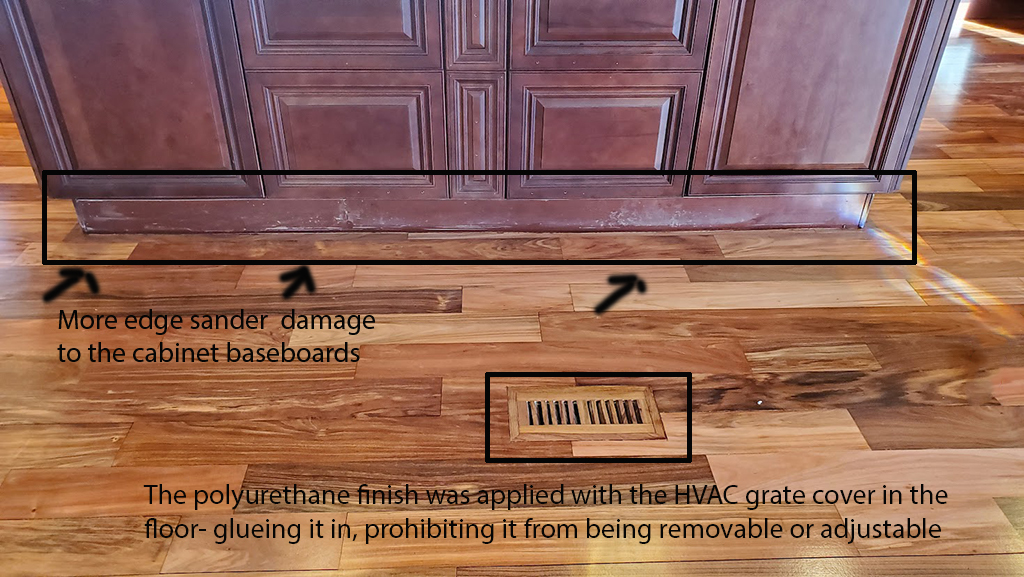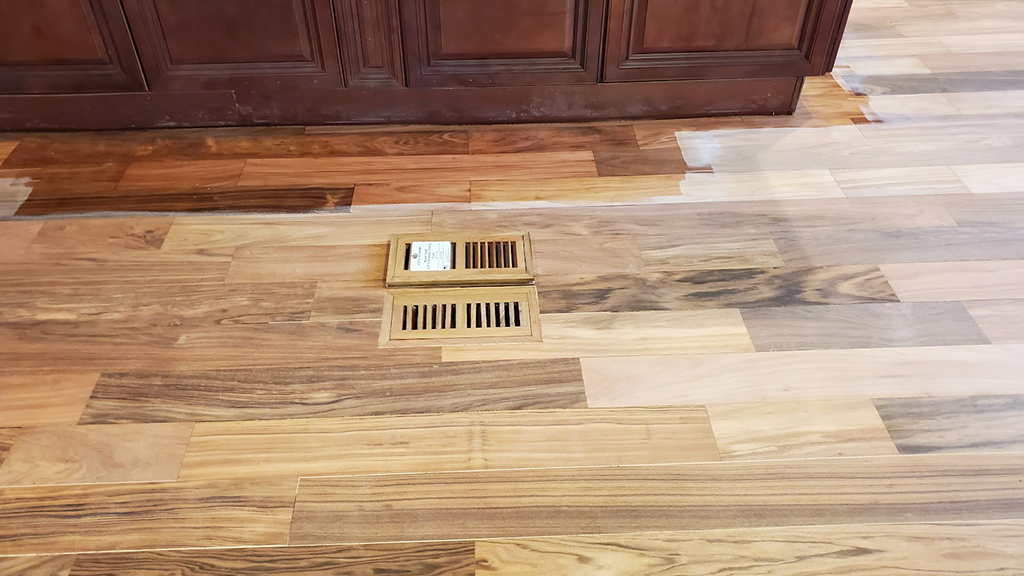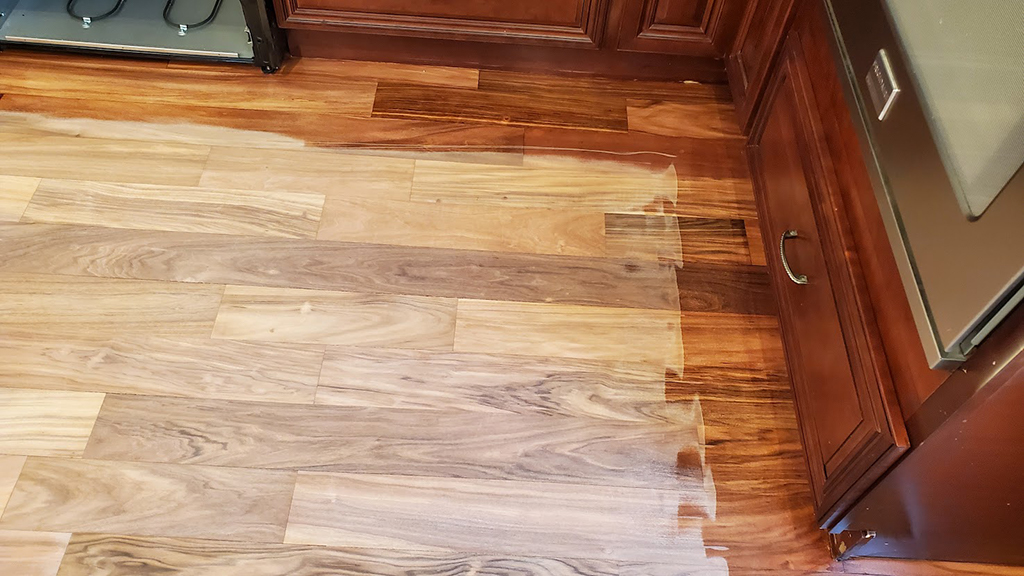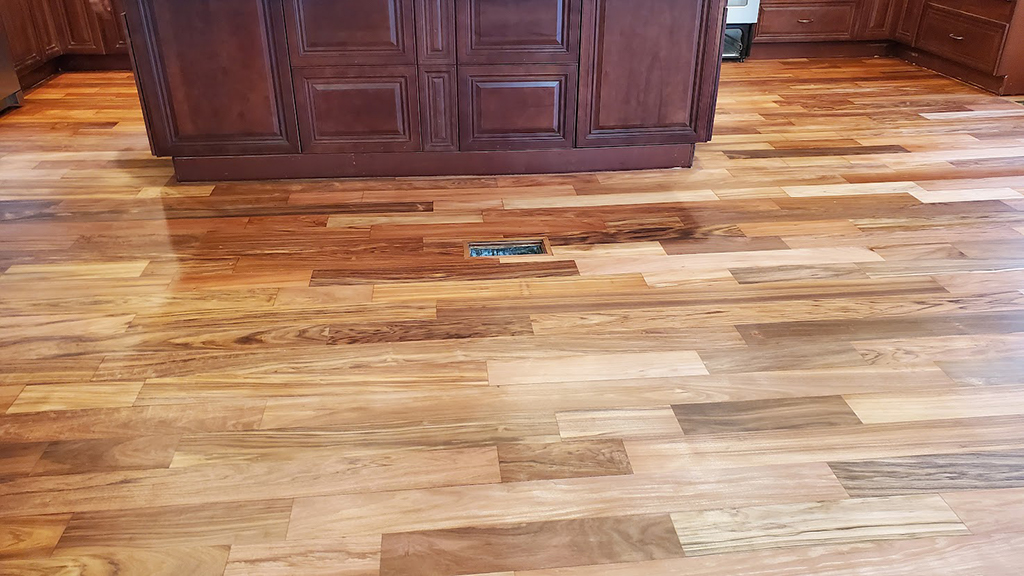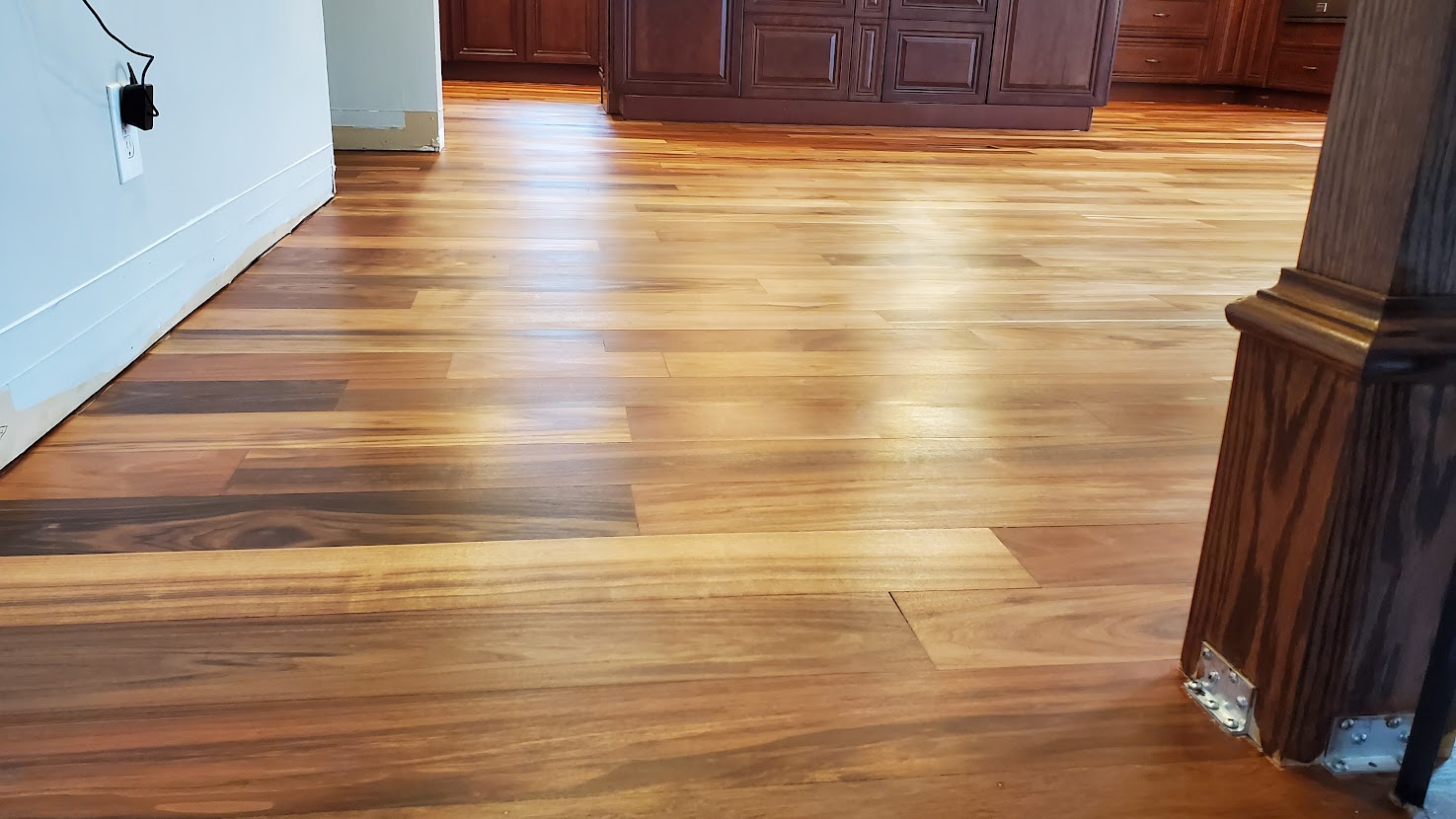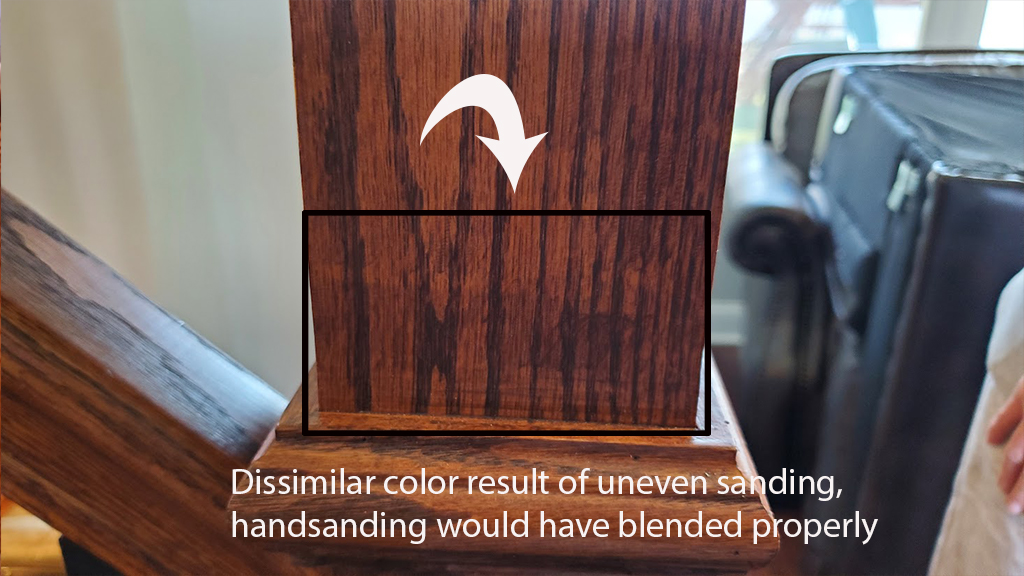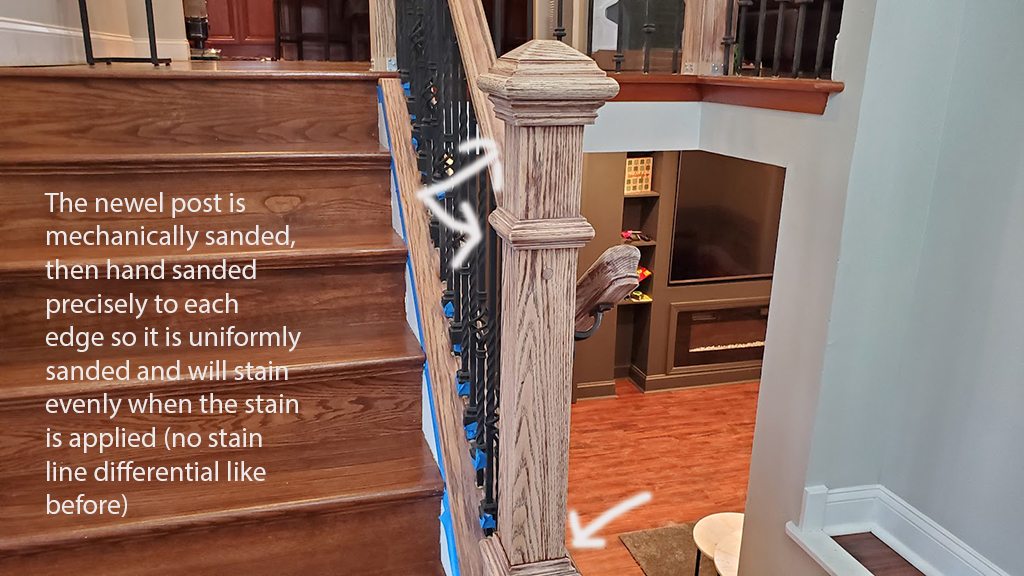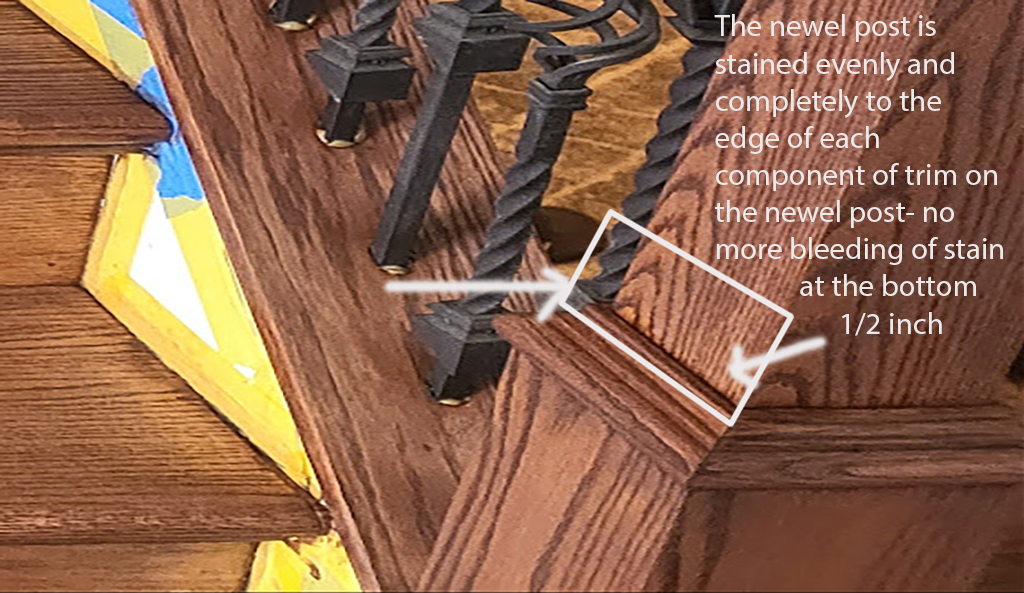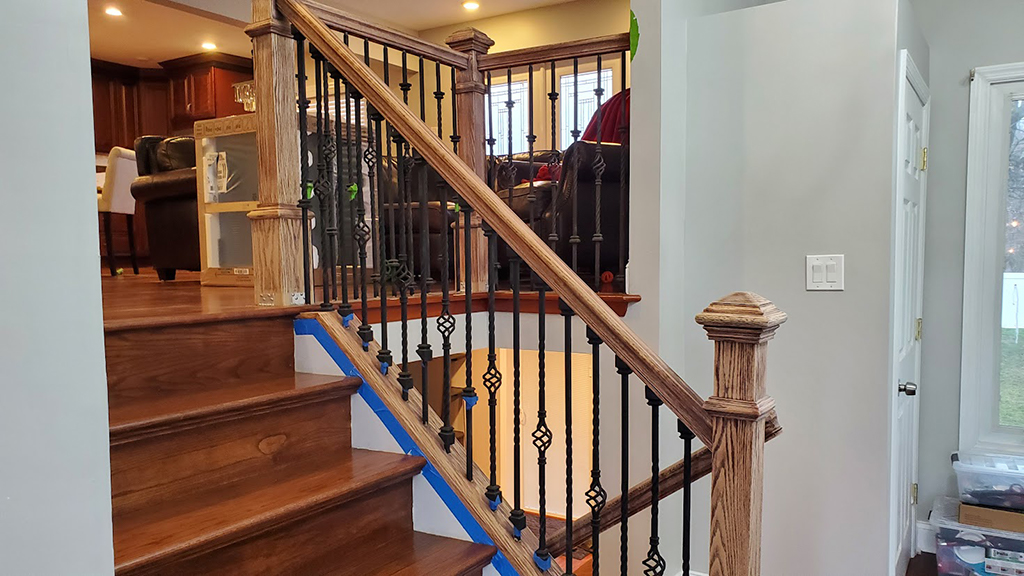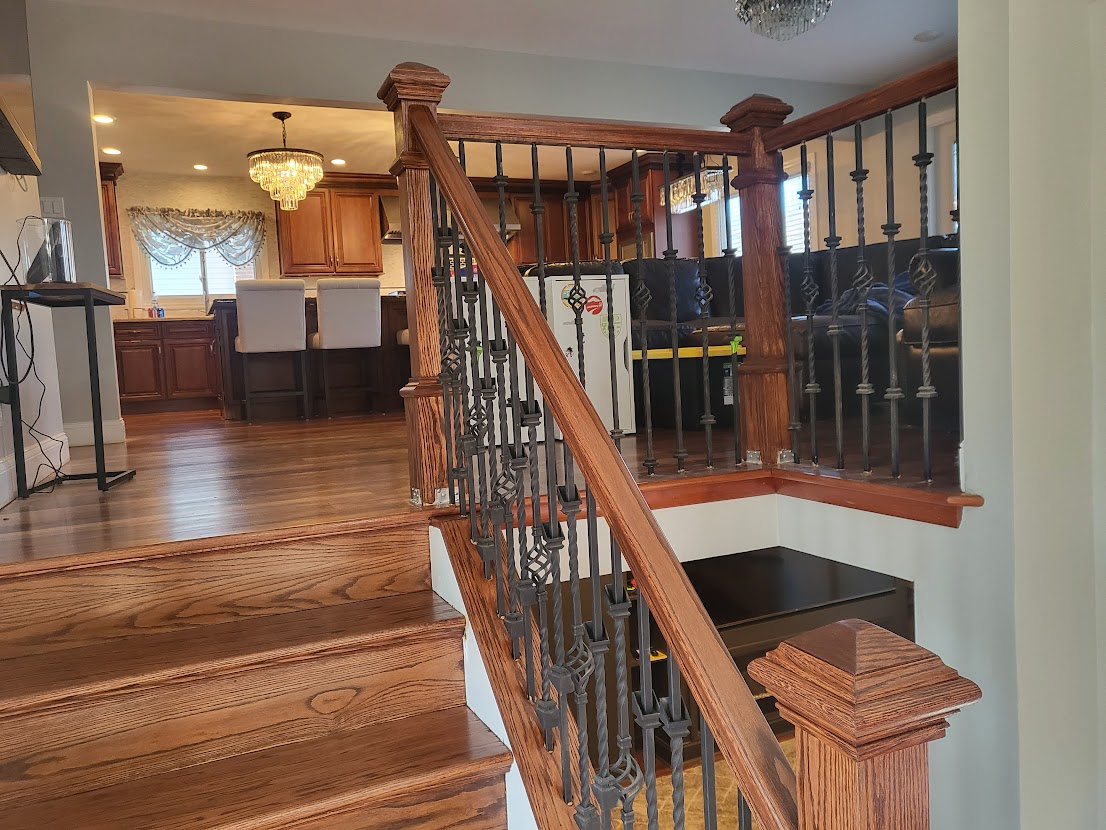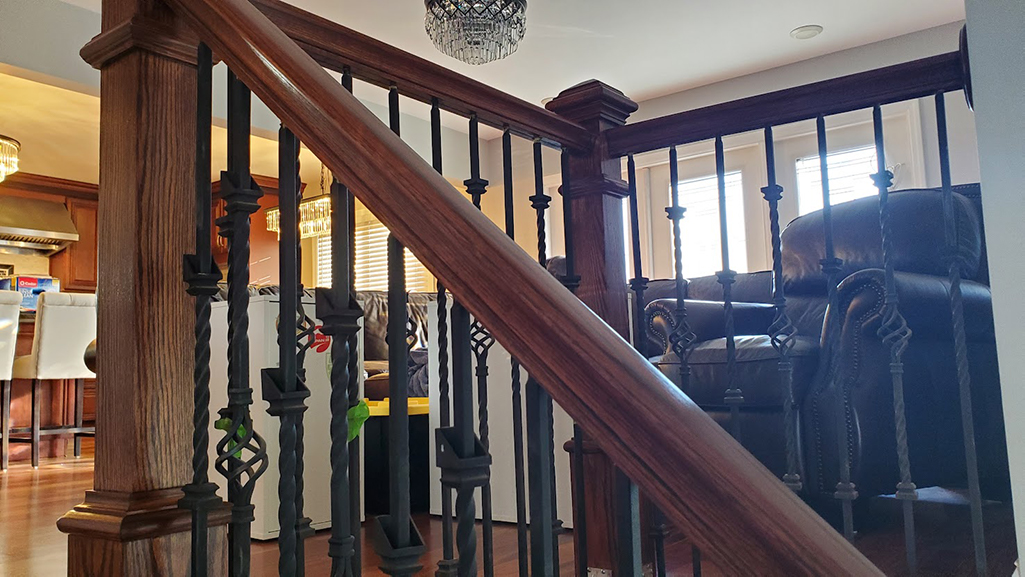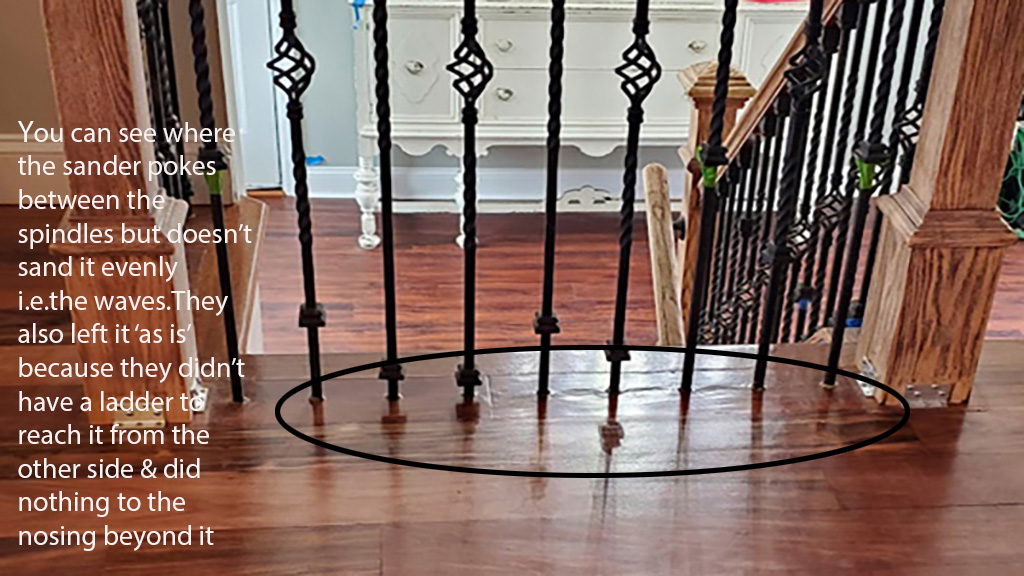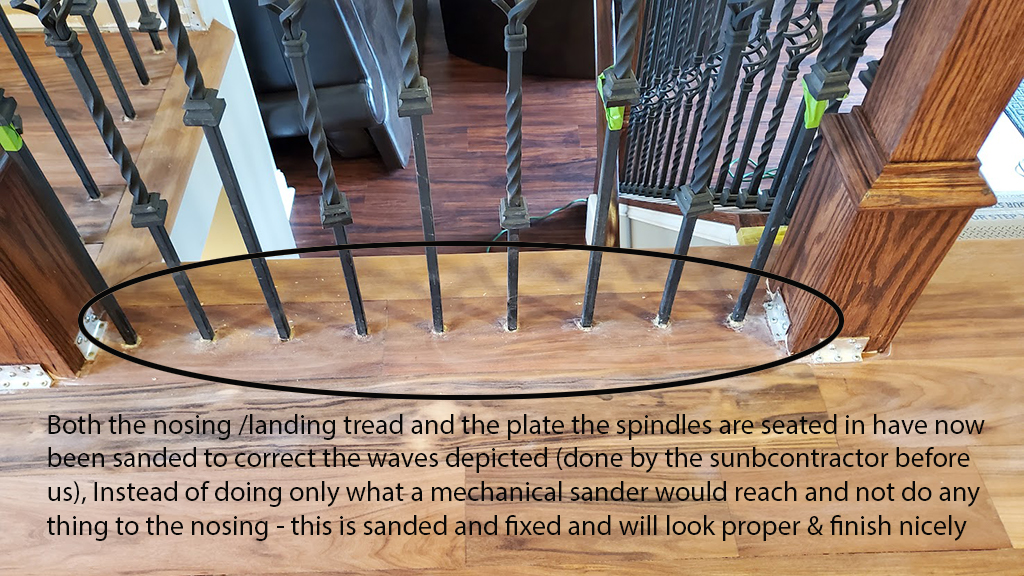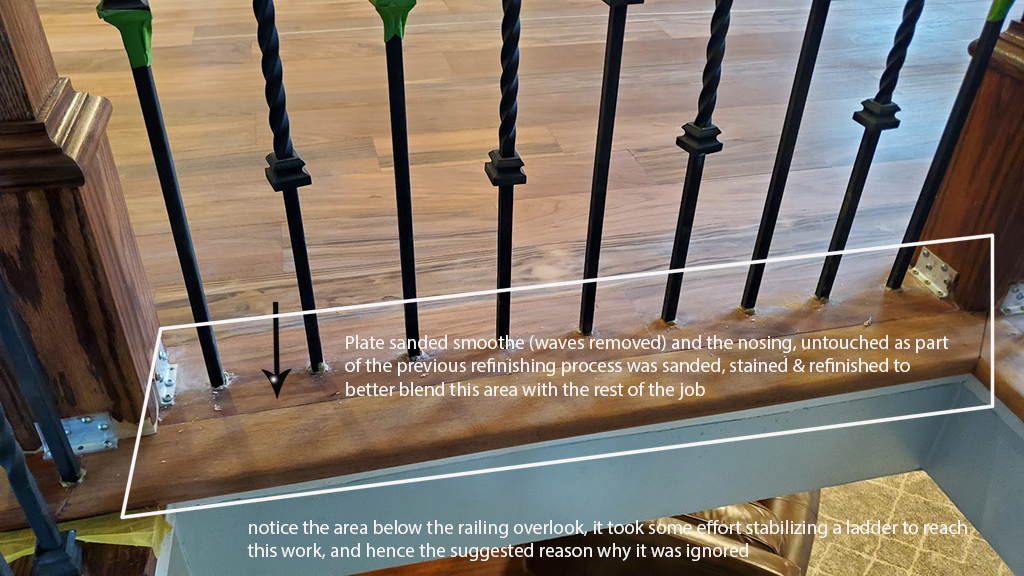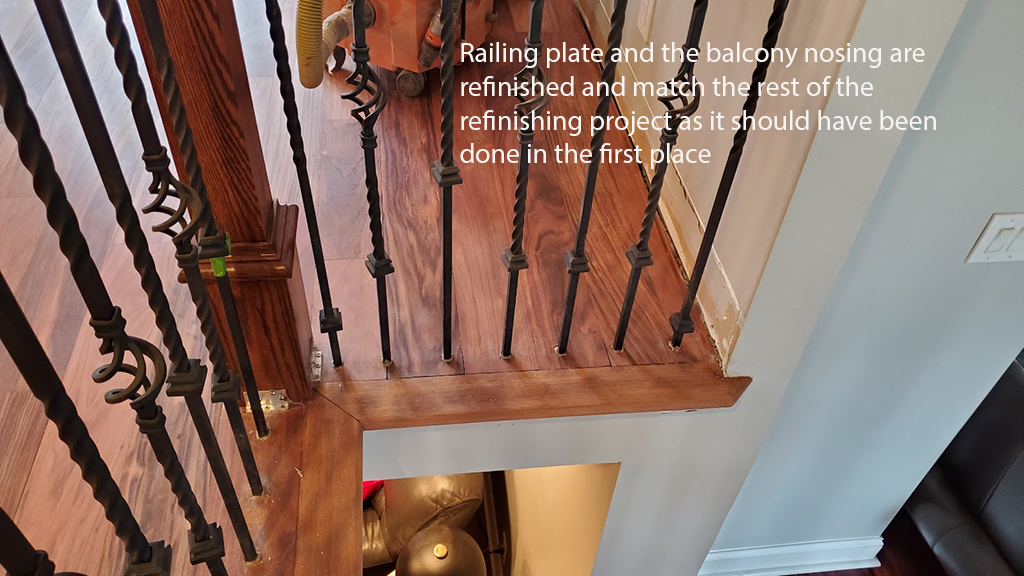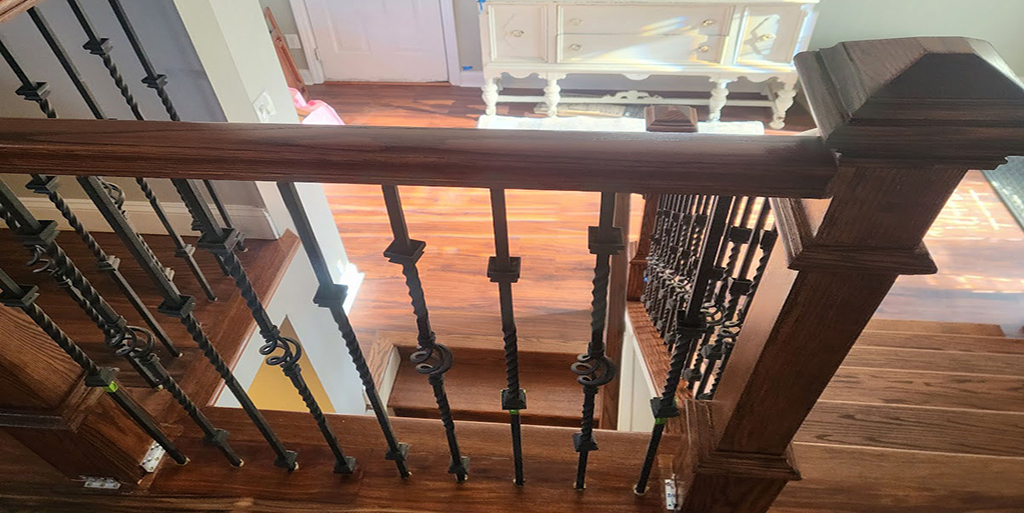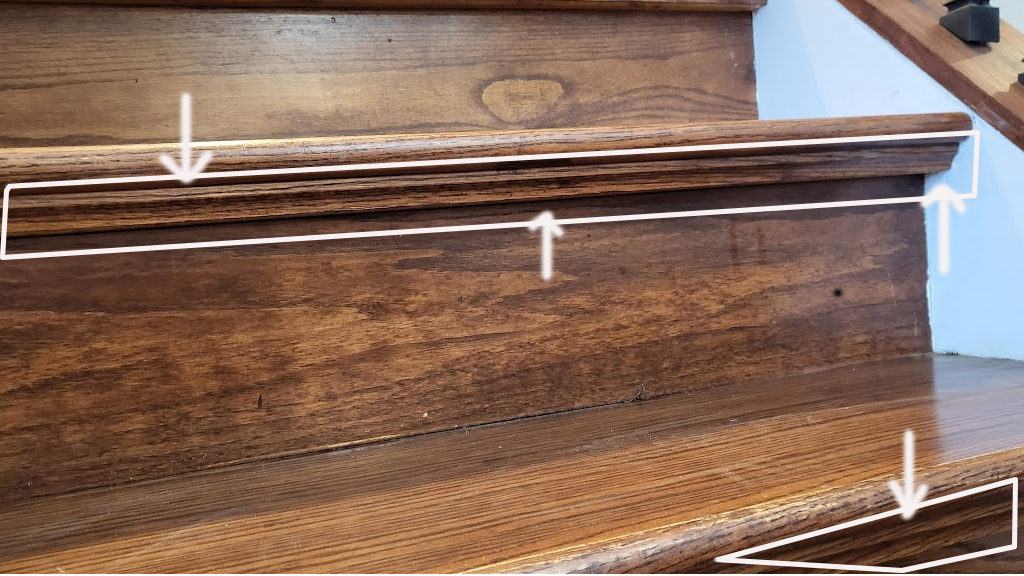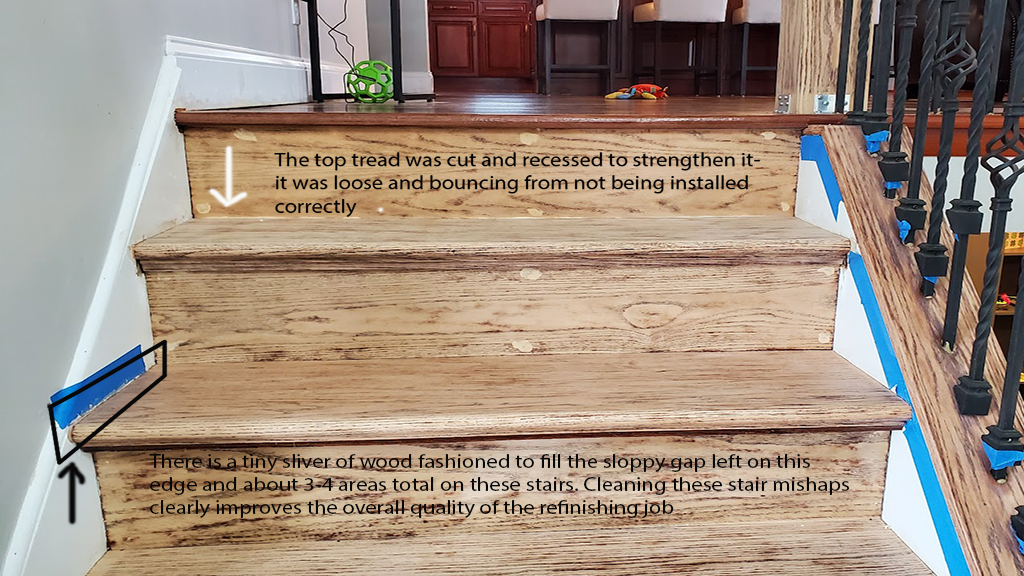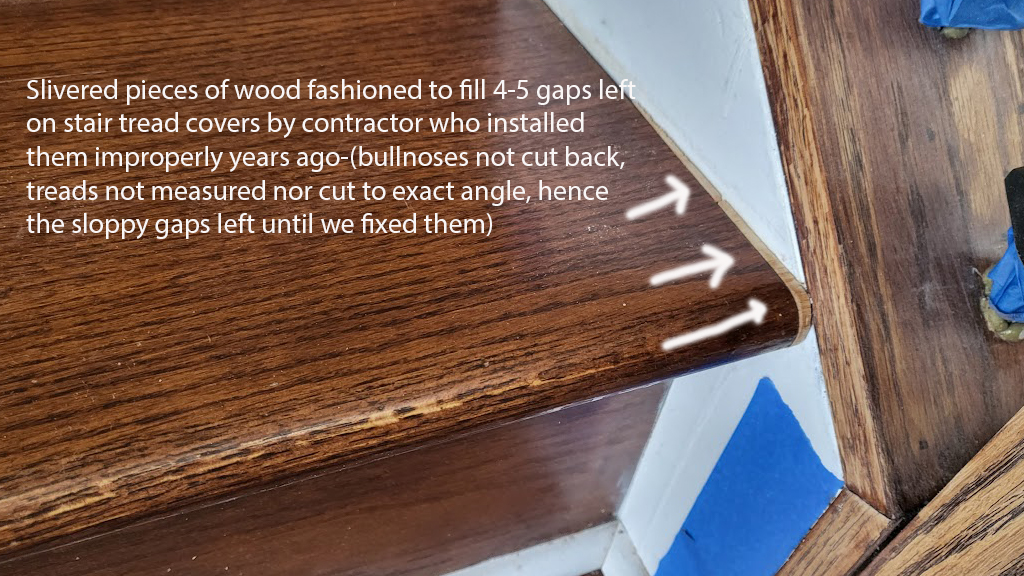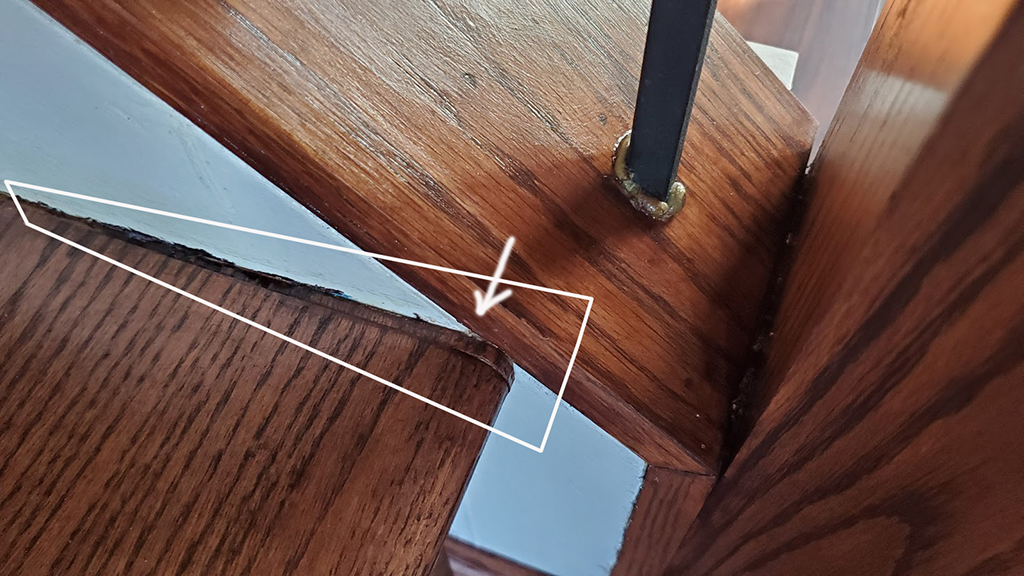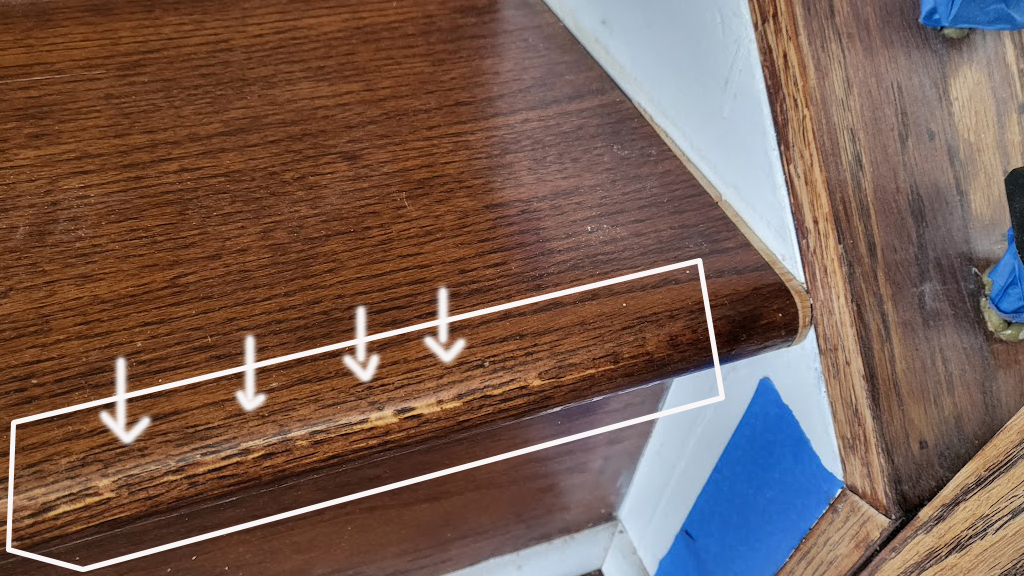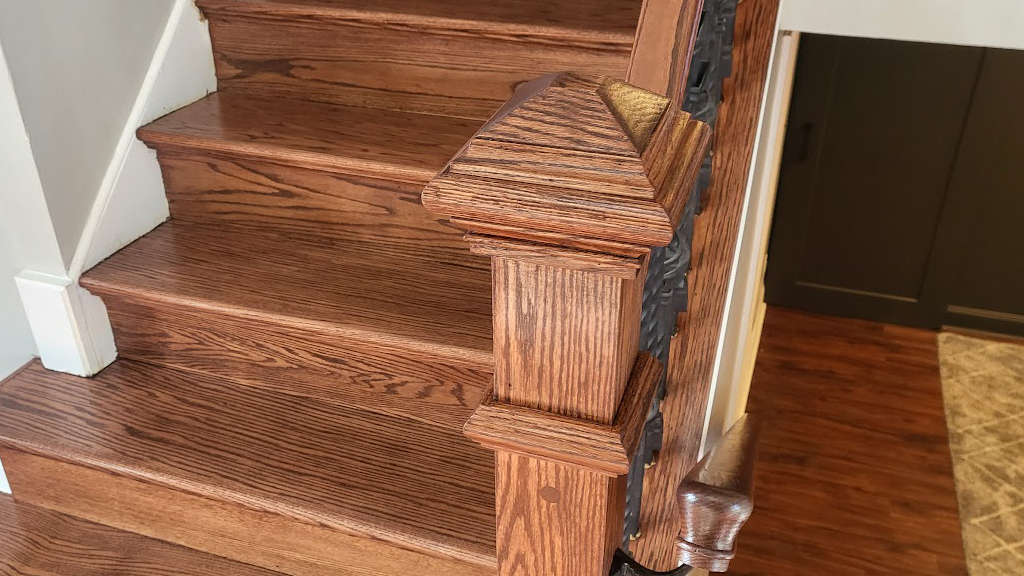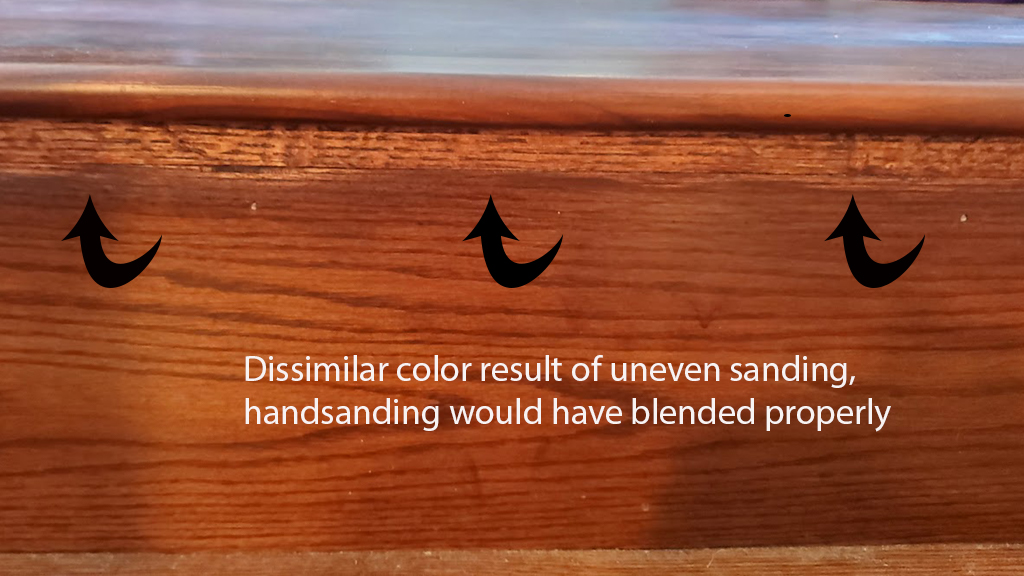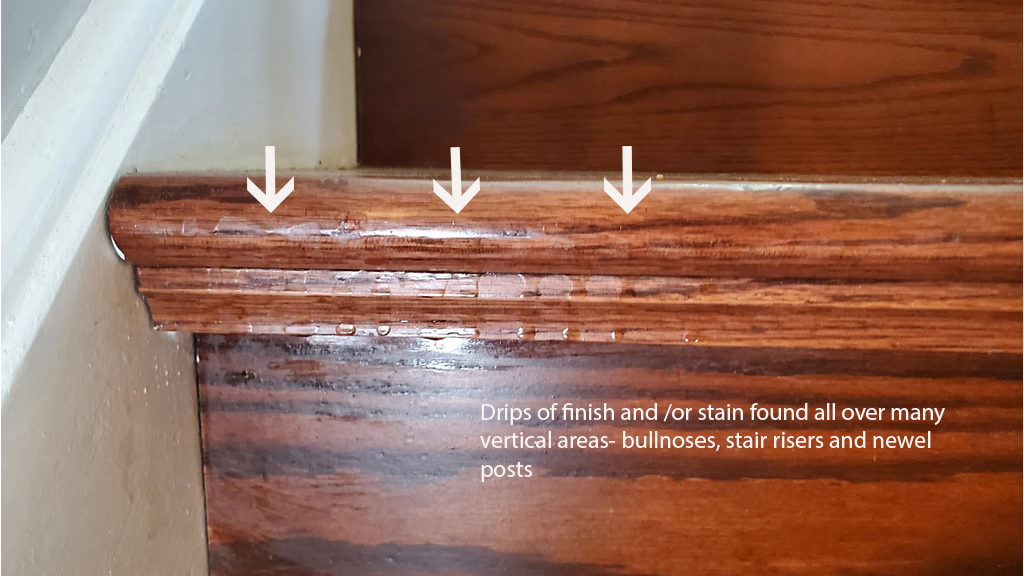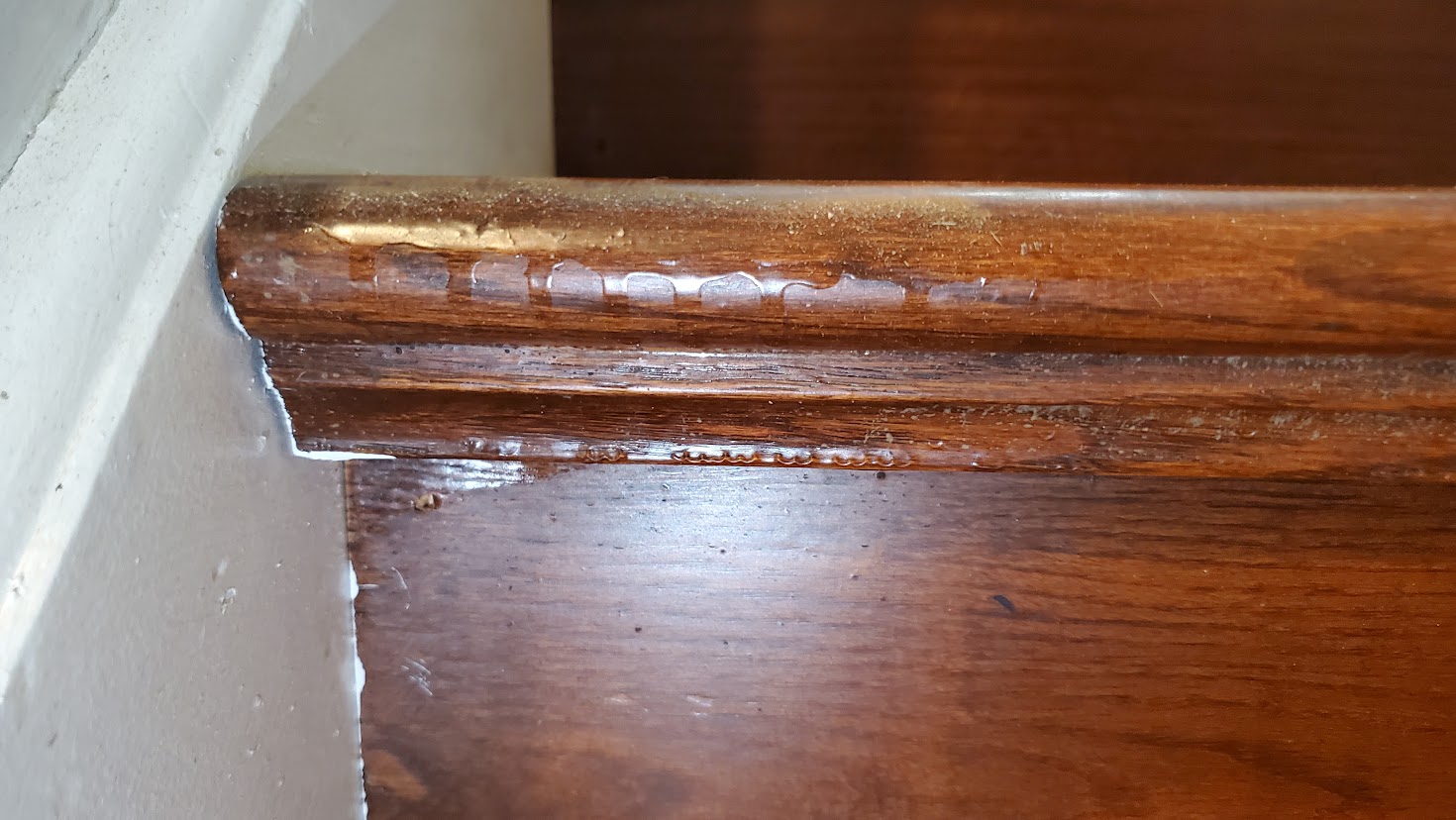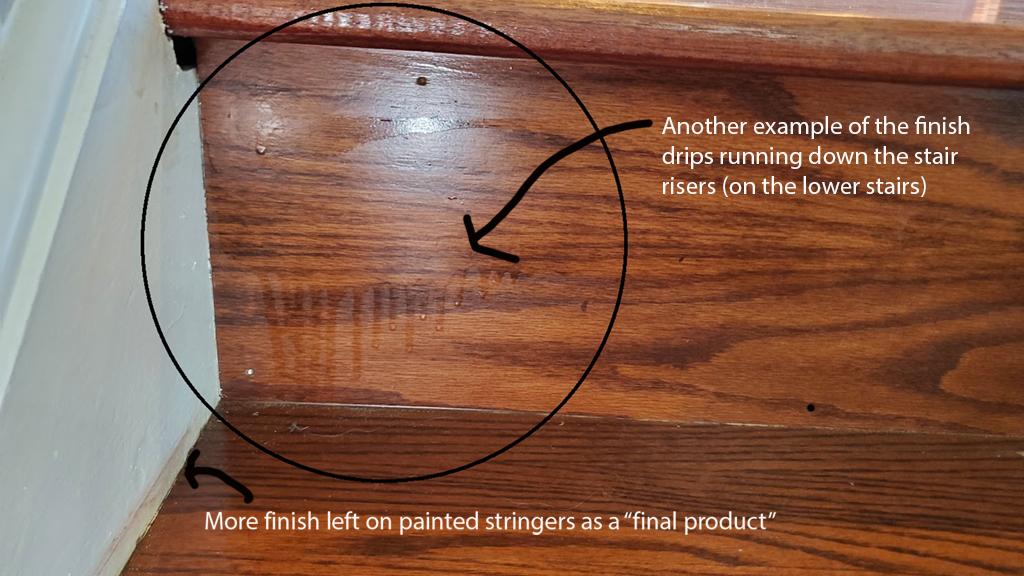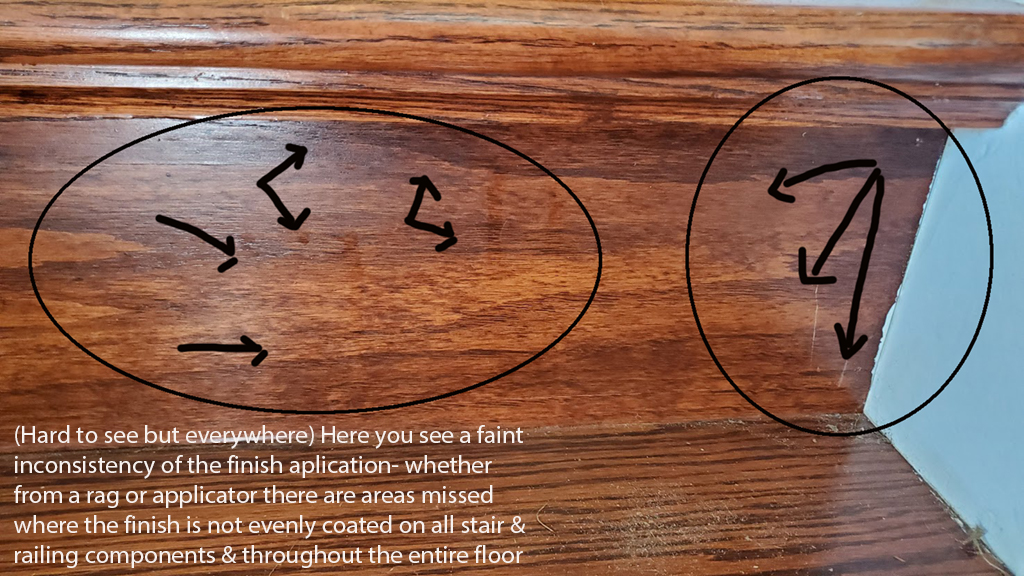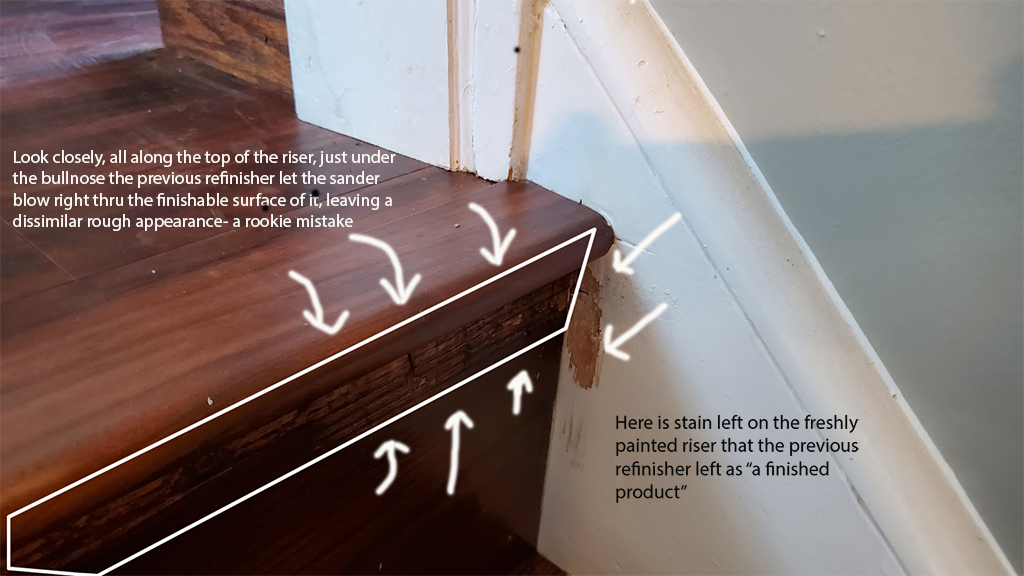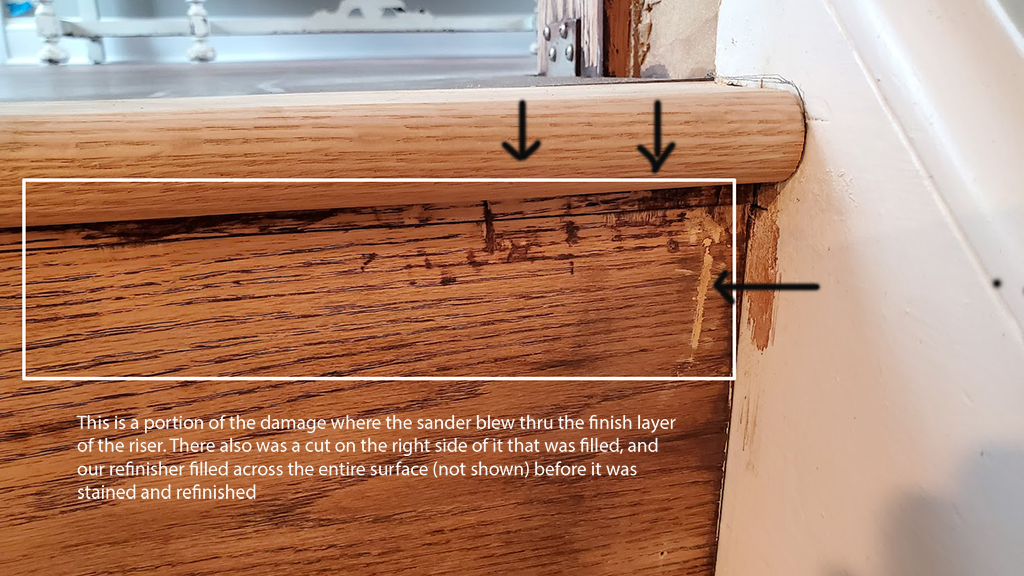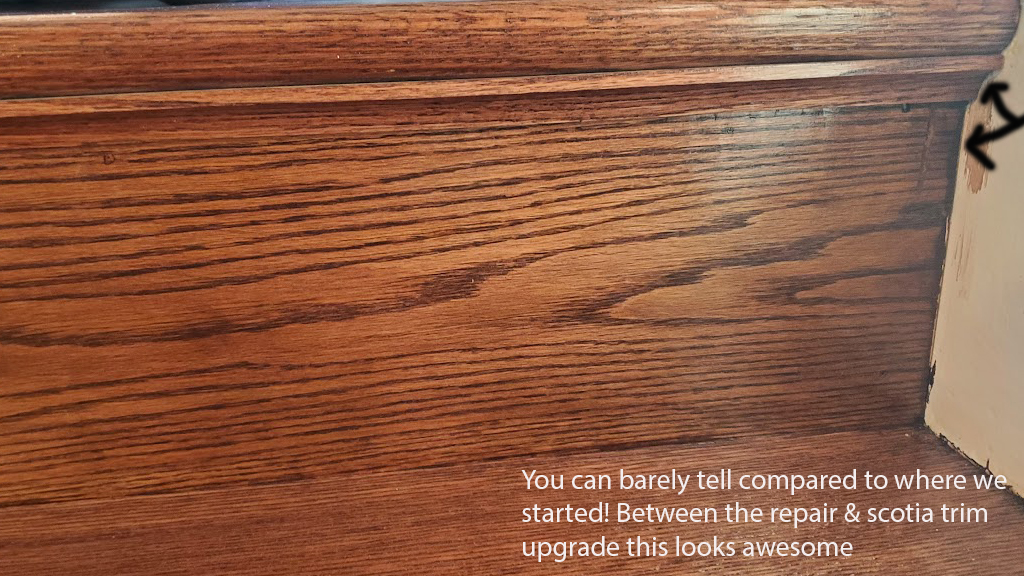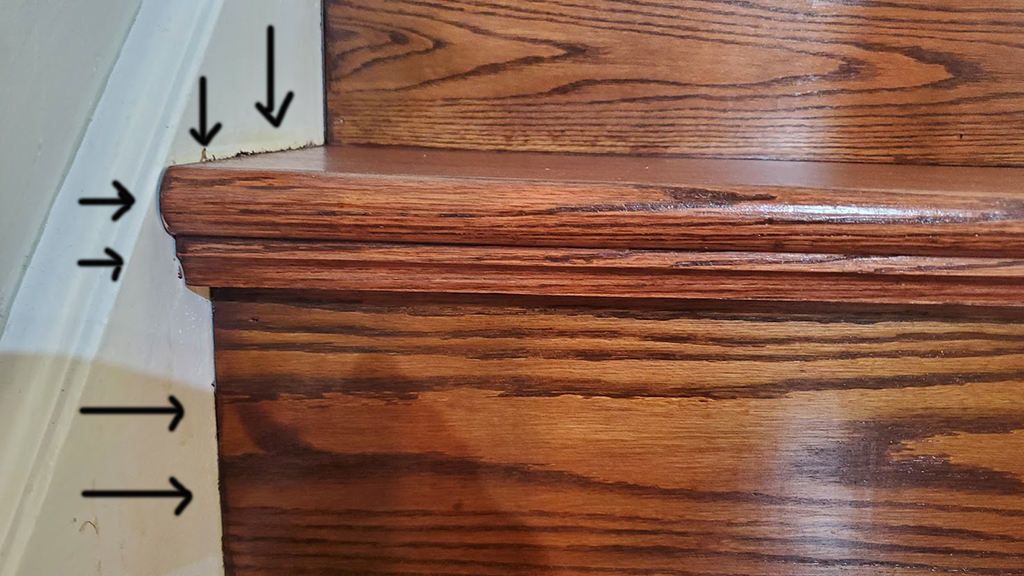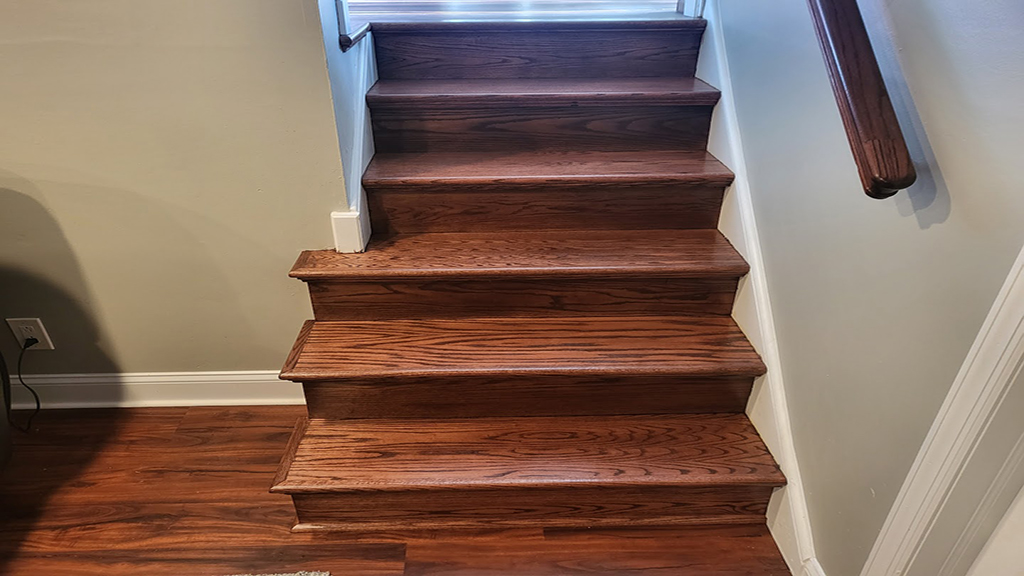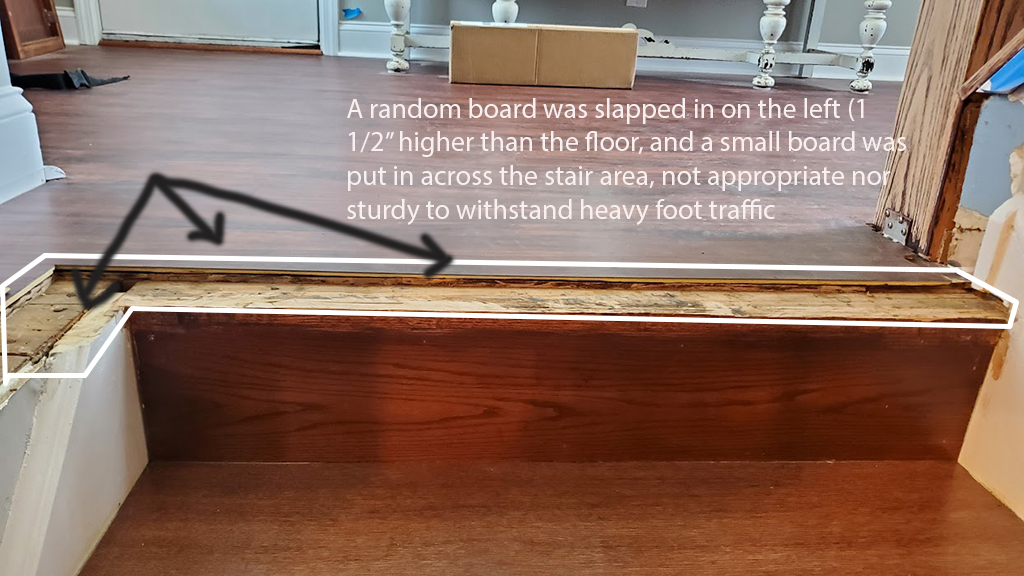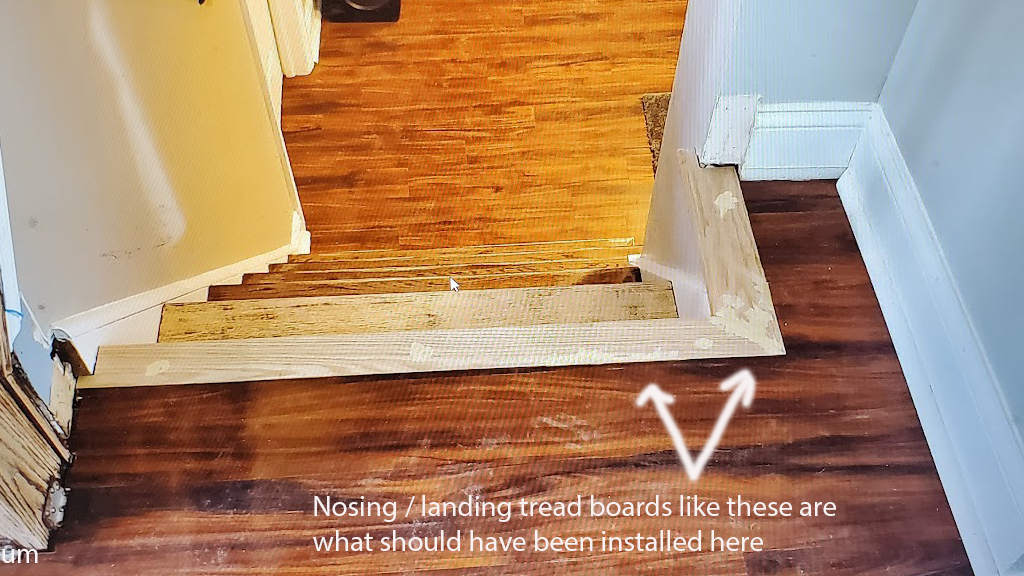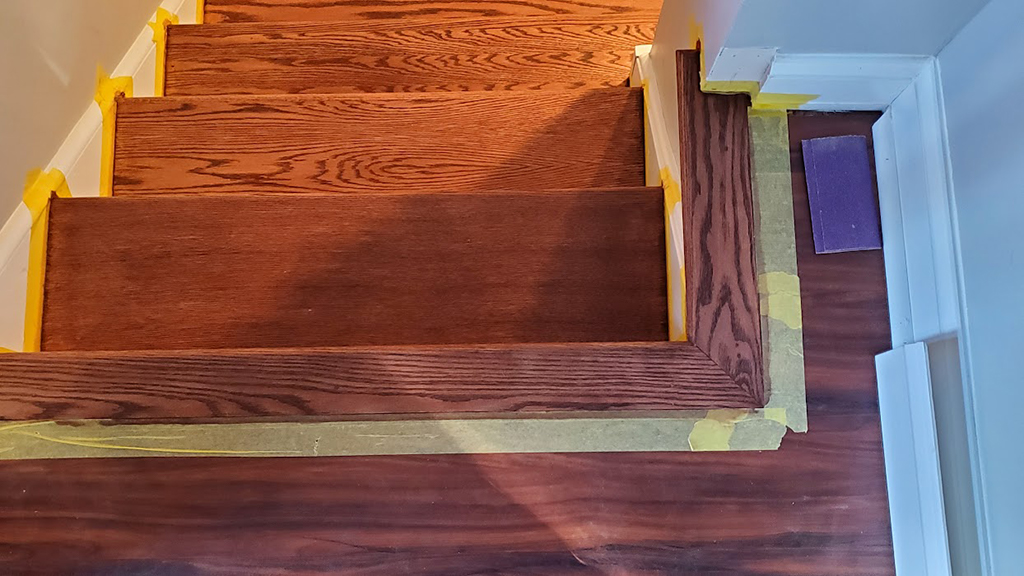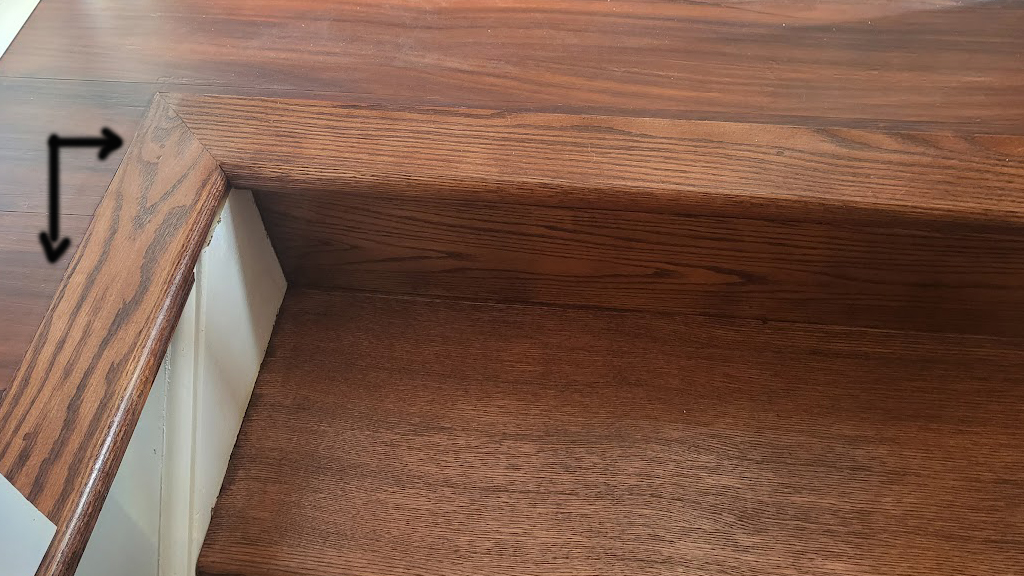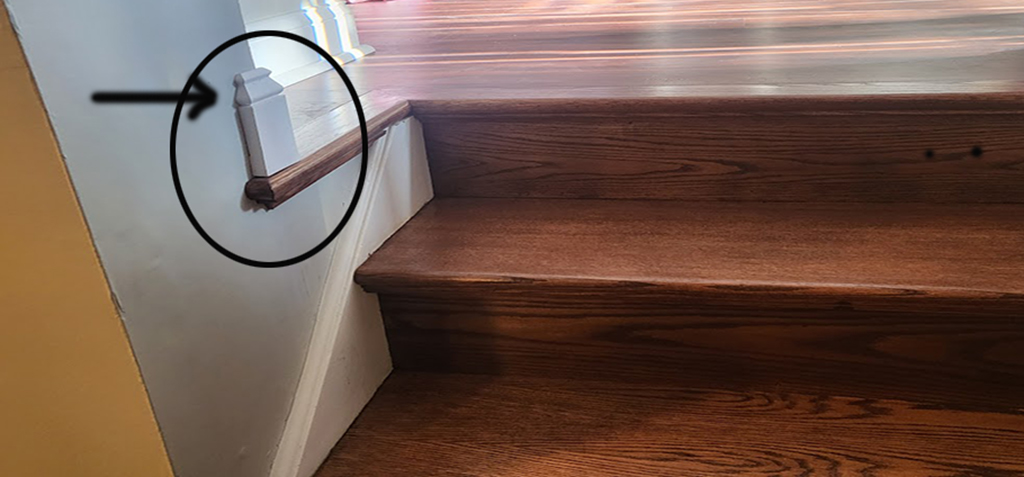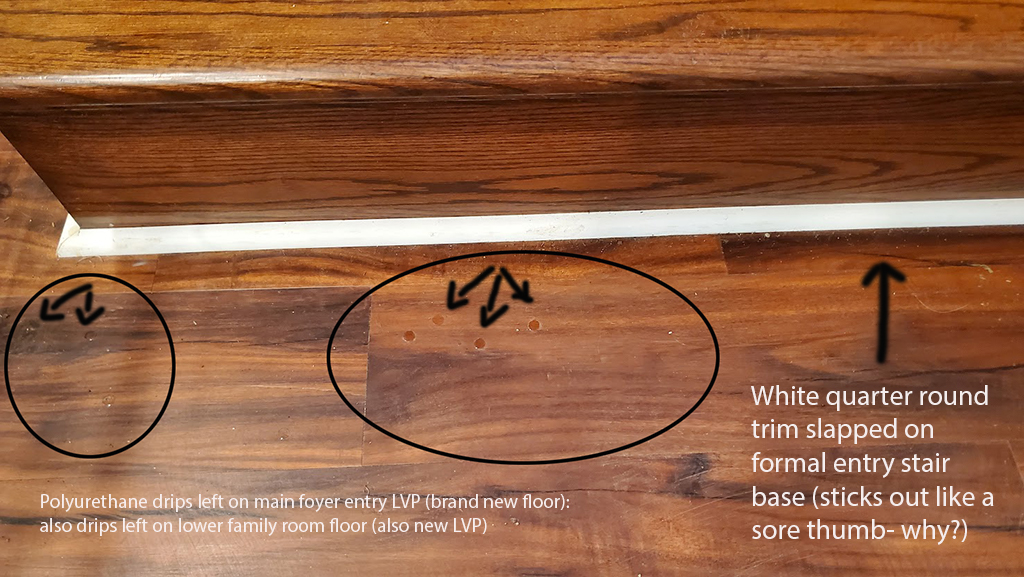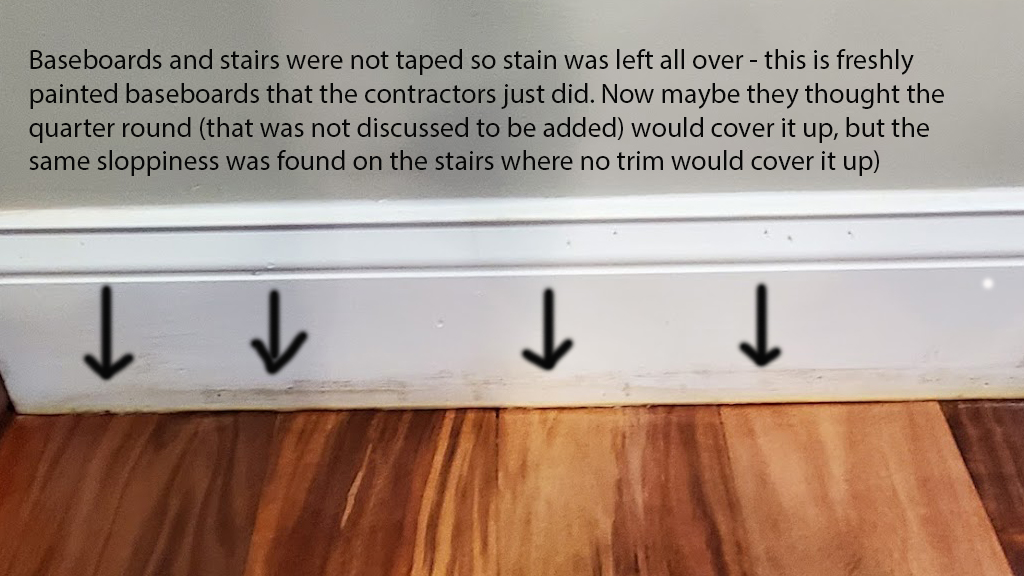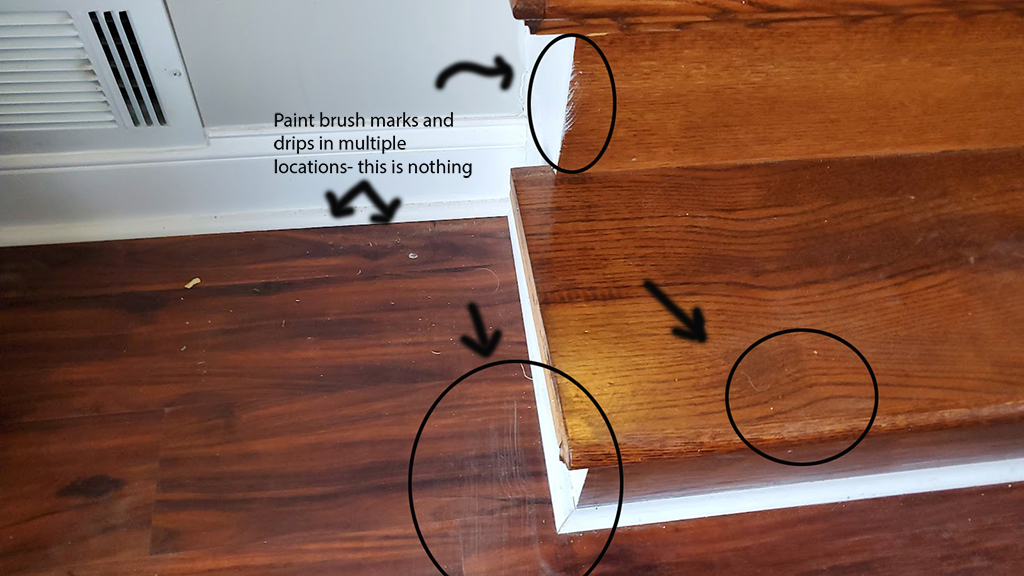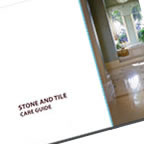Fixing a Santos Mahogany Hardwood Refinishing Failure…
- Home Case Studies Fixing a Santos Mahogany Hardwood Refinishing Failure…
- Client: Mt Laurel
-
Info :
Fixing hardwood floor and railing refinishing failure
After 2 fixing attempts for her wood floors, client “stopped the bleeding” and hired us to rescue them.
A Mount Laurel client quietly sought to have her hardwood floor and railings corrected after a contractor’s sub found himself in over his head. The client was pleased with the general contractor’s work overall (really nice guy, does good work and has a good reputation), but this part of the project was not as successful.
With hardwood floor refinishing this work should be left to professionals who do it daily.
While all kudos go to the general contractor, when he heard and then saw the problems, he too concurred the work left a lot to be desired. (And while our company policy is to band together with our “contractor” brothers and sisters, we don’t diss anyone as a practice. But this one tips the scales. Our client was dealt a hand with problems on this one. As a finished product they could not be ignored. And for the money paid it was unacceptable.
Even after 2 re-sanding attempts to correct the problems, it became evident and clear that the sub-contractor was in over his head. So, should the homeowner be stuck paying for a failed job? Not when it affects all of their main living area and the stairs, the foyer and downstairs family room (and client is in tears) and costs them thousands of dollars—essentially all the living areas in their house.
Despite seeing our work in person first hand and admiring it, she allowed her GC to talk her into using ‘his guy’.
She had allowed herself to be swayed into letting the general contractor bring his sub-contractor in to do the refinishing without ever seeing his work. About ready to see us on the very next morning, she abruptly canceled, even as we got into the car to go see her.
From what we could glean that happened—perhaps it was easier, he was already there. She liked him and the work he was doing so far. What’s not to worry!
Perhaps it was a mistake in hindsight!
The recommended sub-contractor was hired. At the time the various tasks were executed the homeowner packed her dogs and headed to their shore house to get out of the way. Chris left her husband home, who could work from home while coming and going and dealing with the hardwood floor project.
It was pretty quick, and before she knew it her husband called her at the shore to tell her that the hardwood floor refinishing project was finished. When she asked him how it looked, he said it looked good. All excited Chris couldn’t wait to see them.
Instead she was aghast at what she saw. Speechless, she said “Hun you call this a good job, are you serious?
At every turn she found issues. There were numerous blemishes, not just a couple (which maybe, just a few she could stomach). Overall the floors looked weird. The coating looked funny, not like before they started. She looked closer and a whole lot of things drew red flags too. Beyond the finish there was sloppy work, things never touched, things slapped in that didn’t belong, rough railings that weren’t that way before. She saw drips, discoloration and finish not just on the floors, but on the newly painted trim and the walls. And since they painted too, there was paint splatter too that was left in numerous places on the floor. All in all many things just weren’t right.
Dialing in and scrutinizing a little closer, she began to see many aspects of the job were flawed: the carpentry, the finish, the staining, and the finished product. And it affected the floors, her cabinets, her baseboards, the steps, the railings, and even the adjacent new floors (LVP), recently installed in the foyer and lower level family room. Too much, she had no recourse but to pull the plug!
Despondent and sad Chris was determined to have the job fixed!
In her thinking and to her husband she questioned “and they called this a finished product?” She was really annoyed the sub-contractor presented this as his finished product. Were they serious? Being polite and biting her lip she was upset and sad this happened, but determined to have it fixed. Despite liking her contractor and his work, she was not going to settle for the job as it was done by his subcontractor. And if only it were improved a bit she could be happier.
In a polite way she called the sub-contractor back, and they eagerly returned to correct the problems.
Without skipping a beat, the sub-contractor returned to re-do everything and make it right. Sanding everything down, they redid the work. Watching the re-work, little if anything changed.
Dissatisfied still, and wanting it to be right for all involved, Chris (with frustration) called them back again.
And again, really none of the items on her “hit list” were corrected. It was more of the same. (Honestly, given the species of the wood “alligatoring” that would never be corrected if the contaminant wasn’t removed. And since they had no knowledge of what was causing it, they couldn’t fix it.) Moreover unless they changed the sanding pattern and technique, the stain and the finish would never improve either. And the list still continued, even compounded.
Enough was enough and our client reached out to us to “stop the bleeding.”
Kind of thinking she had us in her back pocket, Chris reached out, and asked for help. Not knowing all the details we arrived and inspected the floor and railing job. Immediately we saw her main concerns (and more). Being respectful to the existing contracting this work was an exception. There were too many issues and concurred she shouldn’t take a blind eye (actually in totality, we eventually had 45 different items that made the punch list of issues that were red flags).
We agreed the project as a whole had to be fixed. So for the next hour and and a half we added things to the list.
We found many issues, among them were these most significant ones:
- The species of wood, Santos Mahogany reacted to the finish application. Due to the species, it will never accept an oil-based finish. He tried. (But after the original application, and 2 subsequent sandings’ and coating attempts it was never going to be right.) As a result the finish developed a failure condition called “alligatoring.” Considered a major work failure, the contractor never should have attempted to use this finish on this species of wood. (If they were unfamiliar, they should have researched the correct finish application for this floor.)
- There were swirl marks all over the “field” or main part of the floor. This was evidence that a mechanical sander did the bulk of the work, but was not “fine sanded out” to remove the swirl marks commonly left with this sander.
- A deformed board was not replaced, leaving marks in the board that was dissimilar to the remainder of the boards in the “field.”
- And patch areas around the refrigerator were left, evidence they didn’t sand or refinish near it because they couldn’t reach it with the hand sander.
- Also, the cabinet bases on the island and all along the run of wall cabinets had blunt damage marks where the hand sander ground off the finish of the base cabinets.
- The flush mount vent by the island was coated over with finish, so now you couldn’t remove the grill to adjust the damper to open and close it. (The finish glued it in place- simply because it was not removed before coating; All that needed done is to remove it, apply the finish to the frame, apply the finish separately to the grill cover while out of the frame, and then re-install it when both the frame and grill were dry.)
- The stairs, railing, newel posts, nosing and landing tread were left awry. Most of these components should have been thoroughly hand sanded, but weren’t and there were telltale signs they weren’t. Waves in the wood where the palm sander stopped was one such hint, the waves were left because they did not hand sand them out (around the spindles).
- The railing was not hand sanded “all the way down.” The result was uneven stain color—too light in some areas, and too dark in other s..
- Above where the waves were left and just beyond, there was evidence of old finish, a telling clue they left it alone because they did not want to do the hand sanding and staining to make it blend properly.
- Stair-tread caps were installed incorrectly (by a previous contractor), and not corrected by the refinishing sub-contractor. The top tread was loose, the edges of the caps were short, and unsightly gaps were left. Trim on a board was loose, and scotia trim was not installed as a proper “finish product” as part of the stair work.
- The nosing to the lower floor was sloppy, it should have been replaced. Along with a new nosing, they should have installed another piece of the combo baseboard trim, wrapped it around the corner. And just beyond that they should have finished it with a small block with return quarter round for a “finished” custom look.
- Drips and pulls (of the stain and finish) were left on the bullnoses of the stairs, the risers, and the newel posts. Other drips of finish “fouled” the adjacent LVP floor, as well as the recently painted baseboard trim and wall edges.
- There was paint splatter left to foul the stained treads and the LVP in the foyer and the lower family room, and stain fouled the newly painted baseboard trim (where they didn’t tape- a precautionary task that protects the baseboard).
- And believe me, this was a shortened version of the problems, there were many more.
Chris hired us on the spot, and we assured her we’d make it all right.
It was the last day of February. We spent some time with her and John, answering their questions and answering could we fix the issues and make the floors look better. We freely answered yes, and during the meeting we referred to our Picture Gallery (a section of our website called Case Studies). To see various project’ pictures before and after→ click here Case Studies- Picture Gallery (before & after shots). We acknowledged we would fit her into a packed schedule if she could be flexible. Gracious for the help, we promised to get going on her project asap, and we left with a deposit in hand.
She and her husband were guardedly relieved already, for she had stopped the bleeding.
In fact she was holding back tears on several occasions during our meeting, and really sad this happened. Despite liking her contractor and his work, she was not going to settle for the job as it was done by the subcontractor, whether liking the general contractor or not. Now re-sanded twice with no improvement to address the many concerns either of the times. You just don’t do the same thing, not once, twice but perhaps a third time thinking you would get a different outcome—and she (they) were right.
Turns out we had a chance to sneak on her floor right away—and the restoration list began to grow.
To put it mildly, when our tech started he had his hands full. Each day our client saw corrections right before her very eyes as he fixed every item on her list, and even more we discovered and brought to her attention each of the coming days. Fixing them gave her immediate relief, and she was overcome with pure joy. She couldn’t have been more relieved! And when done, she was over the moon thrilled with her floors and our workmanship, and honestly now had tears of joy! The floors and railings were fixed, and gorgeous. And she admitted she only ever hoped they would be a little better.
What took them a mere number of days took us 3+ weeks (the repairs took 2-3 days alone, and the sanding repairs took time, and the regular sanding pattern ((done properly, and much by hand)) took days too).
She never dreamed they would turn out as perfect as they did!
With a very generous tip given (the biggest one our technician has ever received to date) and a smile on her face you can’t erase, she has become a “champion referring” client of ours.
Not just craftsmanship, according to our client, our hardwood floor technician’s work was “Hardwood floor craftsmanship-artistry.”
Our client wants to warn others to vet out a seasoned hardwood floor refinisher carefully.
Despite having a proven hardwood floor refinisher vetted out, Chris ( in charge) was swayed differently.
Not every contractor is capable of rising to the challenge of hardwood floor refinishing. I cannot stress enough choosing a hardwood floor refinisher worth their salt is a slippery slope at best. Perhaps these are some suggestions you might consider while researching and proving a professional. Click here to read them and ask your prospective refinisher: A Deeper Dive Into Vetting a Hardwood Floor Refinisher Worth Their Salt
To Date- Our clients Chris and John await their “reveal”…
After a 30 day cure; the protective Ramboard™ will be removed, and their completed and fully cured floor will be uncovered…
With the work being done almost 30 days now, we are invited to their “Reveal,” for when the special protective Ramboard™ is removed from the floor, and it awaits being introduced as a finished, fully cured product. When this happens Chris has already pledged she wants to do a recorded video testimonial about her experience with us in fixing her floors. She wants everyone to know, and is proud to tell whomever will listen how we saved her floors and how amazingly gorgeous they are (remember she only ever hoped they might be a little better than what the sub-contractor did!)
Never in her wildest dreams did she expect to get the beautifully restored hardwood floors and railings we gave her!
Need a consult on a questionable hardwood floor refinishing give us a call. Free estimate give us a call at 609.953.0472. Contact Us on line and we will reach out to you!



